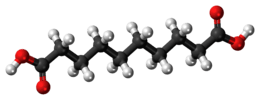Sebacic acid
 | |
 | |
| Names | |
|---|---|
| IUPAC name
Decanedioic acid | |
| Other names
1,8-Octanedicarboxylic acid | |
| Identifiers | |
| 111-20-6 | |
| 3D model (Jmol) | Interactive image |
| ChEBI | CHEBI:CHEBI:41865 |
| ChemSpider | 5004 |
| ECHA InfoCard | 100.003.496 |
| EC Number | 203-845-5 |
| MeSH | C011107 |
| PubChem | 5192 |
| |
| |
| Properties | |
| C10H18O4 | |
| Molar mass | 202.25 g·mol−1 |
| Density | 1.209 g/cm3 |
| Melting point | 131 to 134.5 °C (267.8 to 274.1 °F; 404.1 to 407.6 K) |
| Boiling point | 294.4 °C (561.9 °F; 567.5 K) at 100 mmHg |
| 0.25 g/L[1] | |
| Acidity (pKa) | 4.720, 5.450[1] |
| Except where otherwise noted, data are given for materials in their standard state (at 25 °C [77 °F], 100 kPa). | |
| | |
| Infobox references | |
Sebacic acid is a naturally occurring dicarboxylic acid with the structure (HOOC)(CH2)8(COOH).
In its pure state it is a white flake or powdered crystal. The product is described as non-hazardous, though in its powdered form it can be prone to flash ignition (a typical risk in handling fine organic powders).
Sebaceus is Latin for tallow candle, sebum is Latin for tallow, and refers to its use in the manufacture of candles. Sebacic acid is a derivative of castor oil, with the vast majority of world production occurring in China which annually exports over 100,000 metric tonnes, representing over 90% of global trade of the product.
In the industrial setting, sebacic acid and its homologues such as azelaic acid can be used as a monomer for nylon 610, plasticizers, lubricants, hydraulic fluids, cosmetics, candles, etc. Sebacic acid is also used as an intermediate for aromatics, antiseptics, and painting materials.
Sebacic acid is produced from castor oil by using sodium hydroxide, sulfuric acid with catalysts including zinc oxide and phenol. Byproducts include glycerol, octanol and polymer residue.
References
- 1 2 Bretti, C.; Crea, F.; Foti, C.; Sammartano, S. (2006). "Solubility and Activity Coefficients of Acidic and Basic Nonelectrolytes in Aqueous Salt Solutions. 2. Solubility and Activity Coefficients of Suberic, Azelaic, and Sebacic Acids in NaCl(aq), (CH3)4NCl(aq), and (C2H5)4NI(aq) at Different Ionic Strengths and at t = 25 °C". J. Chem. Eng. Data. 51 (5): 1660–1667. doi:10.1021/je060132t.
External links
- Sebacic acid on chemicalland <-- deadlink